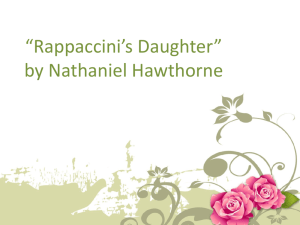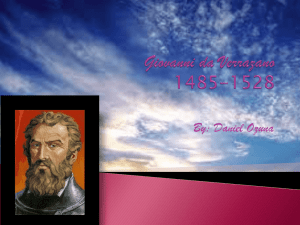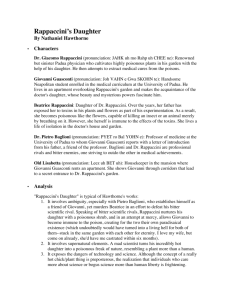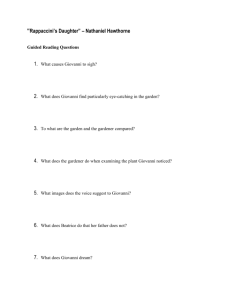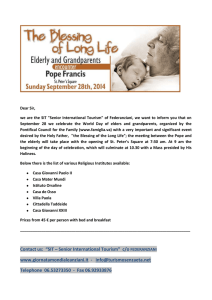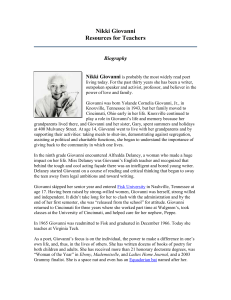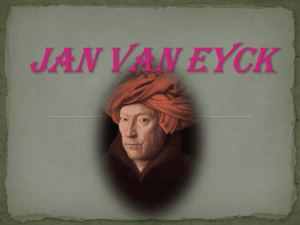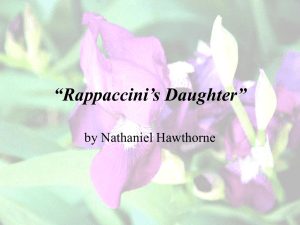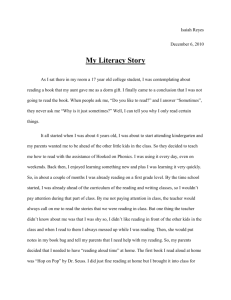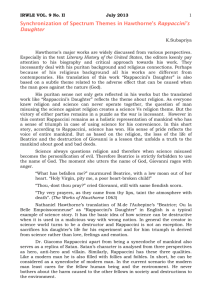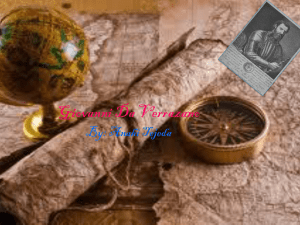1 HAWTHORNE TALES "The Old Manse," from Mosses from an Old
advertisement
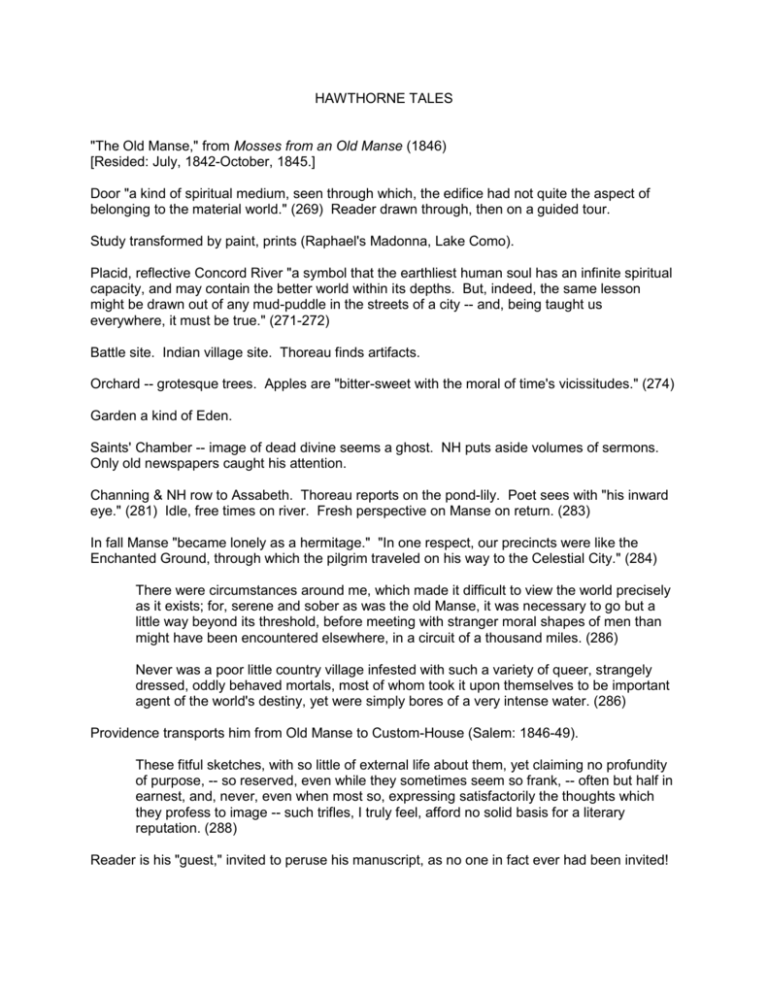
HAWTHORNE TALES "The Old Manse," from Mosses from an Old Manse (1846) [Resided: July, 1842-October, 1845.] Door "a kind of spiritual medium, seen through which, the edifice had not quite the aspect of belonging to the material world." (269) Reader drawn through, then on a guided tour. Study transformed by paint, prints (Raphael's Madonna, Lake Como). Placid, reflective Concord River "a symbol that the earthliest human soul has an infinite spiritual capacity, and may contain the better world within its depths. But, indeed, the same lesson might be drawn out of any mud-puddle in the streets of a city -- and, being taught us everywhere, it must be true." (271-272) Battle site. Indian village site. Thoreau finds artifacts. Orchard -- grotesque trees. Apples are "bitter-sweet with the moral of time's vicissitudes." (274) Garden a kind of Eden. Saints' Chamber -- image of dead divine seems a ghost. NH puts aside volumes of sermons. Only old newspapers caught his attention. Channing & NH row to Assabeth. Thoreau reports on the pond-lily. Poet sees with "his inward eye." (281) Idle, free times on river. Fresh perspective on Manse on return. (283) In fall Manse "became lonely as a hermitage." "In one respect, our precincts were like the Enchanted Ground, through which the pilgrim traveled on his way to the Celestial City." (284) There were circumstances around me, which made it difficult to view the world precisely as it exists; for, serene and sober as was the old Manse, it was necessary to go but a little way beyond its threshold, before meeting with stranger moral shapes of men than might have been encountered elsewhere, in a circuit of a thousand miles. (286) Never was a poor little country village infested with such a variety of queer, strangely dressed, oddly behaved mortals, most of whom took it upon themselves to be important agent of the world's destiny, yet were simply bores of a very intense water. (286) Providence transports him from Old Manse to Custom-House (Salem: 1846-49). These fitful sketches, with so little of external life about them, yet claiming no profundity of purpose, -- so reserved, even while they sometimes seem so frank, -- often but half in earnest, and, never, even when most so, expressing satisfactorily the thoughts which they profess to image -- such trifles, I truly feel, afford no solid basis for a literary reputation. (288) Reader is his "guest," invited to peruse his manuscript, as no one in fact ever had been invited! 2 Preface to the 1851 edition of Twice-told Tales NH describes himself as "for a good many years, the obscurest man of letters in America." Tales have "the pale tint of flowers that blossomed in too retired a shade -- the coolness of a meditative habit, which diffuses itself through the feeling and observation of every sketch. Instead of passion, there is sentiment; and, even in what purports to be pictures of actual life, we have allegory, not always so warmly dressed in its habiliments of flesh and blood, as to be taken into the reader's mind without a shiver...." (290) NH says he was seen "as a mild, shy, gentle, melancholic, exceedingly sensitive, and not very forcible man, hiding his blushes under an assumed name, the quaintness of which was supposed, somehow or other, to symbolize his personal and literary traits." As a result, he may have written to conform to this image. (291) Preface to The Snow-Image "There is no harm, but, on the contrary, good, in arraying some of the ordinary facts of life in a slightly idealized and artistic guise." (292) Bemoans the slowness of his recognition. He would be still sitting amid overgrowth but for Horatio Bridge. From The American Notebooks "There is a fund of evil in every human heart, which may remain latent, perhaps through the whole of life; but circumstances may arouse it to activity. To imagine such circumstances." (312) "The human Heart to be allegorized as a cavern; at the entrance there is sunshine, and flowers growing about it. Yet step within, but a short distance, and begin to find yourself surrounded with a terrible gloom, and monsters of divers kinds; it seems like Hell itself." (318) 2 3 HAWTHORNE -- TALES "Roger Malvin's Burial" 1725 -- "Lovell's Fight" -- heroic? RM & Reuben in woods. Mixed motives and guilty feelings of Reuben stressed. Ties handkerchief to oak sapling. Reuben cannot tell Dorcas, so he is falsely believed to be a hero. Voice beckons him back. Cyrus seems Reuben's younger self. Symbolic forest. Fatal attraction. "Unable to penetrate to the secret place of his soul where his motives lay hidden, he believed that a supernatural voice had called him onward and that a natural power had obstructed his retreat." (29) He fires, kills Cyrus. Withered oak. His sin "expiated"? "The blood of a 'father' rests on the 'son,' who disburdens himself of it by becoming a father and slaying his son. This is the terrible logic of Hawthorne's tale." (384) -- F. Crews "The Gentle Boy" 1656 -- Quakers presented as self-convinced religious idealists. Puritans respond to them "as holders of mystic and pernicious principles." Quakers sought martyrdom. (32-33) Two put to death in Massachusetts in 1659. Ilbrahim, age six, discovered after hangings by Tobias Pearson, who bring him home to wife Dorothy. Tobias guided by "an inward voice." Bigots persecute the Pearsons and the innocent child. Minister preaches against pity. Catharine, boy's mother, unveils herself and denounces congregation --a "flood of malignity which she mistook for inspiration." (41) Two women, two mothers, form a "practical allegory" on each side of boy -- "it was rational piety and unbridled fanaticism, contending for the empire of a young heart." (43)*** Catharine personifies religious fanaticism for NH. (45) Ilbrahim grows up a bit wild -- like Pearl. He oversees the healing of a injured boy. Later this boy, recovered, and other youths turn on Ilbrahim. Months pass. Pearson broods. Elder Quaker recalls how he left the side of his sick daughter to preach -- fanaticism to NH. Catharine appears out of storm -- news of persecution's end. Boy dies. Finally, reconciliation -- as in SL. 3 4 "The Birthmark" Later years of last century. Aylmer, a scientist who tried to control Nature. His love for Georgiana entwined with his love of science. Crimson stain upon her cheek -- emblem of a hand. Impressions vary. (119) Aylmer increasingly disturbed. "It was the fatal flaw of humanity which Nature, in one shape or another, stamps ineffaceably on all her productions, either to imply that they are temporary and finite, or that their perfection must be wrought by toil and pain." (120) Onto her he projects "sin, sorrow, decay, and death." Aminadab (bad anima) -- animalistic aide. vs. spiritual Aylmer. Pygmalion & Faust models. Inner chamber of gorgeous curtains, where he wished "to draw a magic circle round her within which no evil might intrude." Bewitching figures. Blighted plant. Vial of cleansing poison. Folios reveal to her his work. "He handled physical details as if there were nothing beyond them; yet spiritualized them all and redeemed himself from materialism by his strong and eager aspiration towards the infinite. In his grasp the veriest clod of earth assumed a soul." Laboratory -- all transformed. he reveals all and she is enchanted by his love. "Unless all my science has deceived me, it cannot fail." She takes poison. Mark fades -- like disappearing rainbow. She tells him not to repent that he has "rejected the best that earth could offer" as she dies. NH: "Alas! it was too true! The fatal hand had grappled with the mystery of life, and was the bond by which an angelic spirit kept itself in union with a mortal frame." 4 5 "Rappaccini's Daughter: Writings of Aubepine" M de l'Aubepine described (by authorial voice: translator/critic) as "too refined, at all events too remote, too shadowy, and unsubstantial in his modes of development to suit the taste of the latter class, and yet too popular to satisfy the spiritual or metaphysical requisitions of the former," so lacks a large audience. His works suffers from "an inveterate love of allegory, which is apt to invest his plots and characters with the aspect of scenery and people in the clouds and to steal away the human warmth out of his conceptions. His fictions are sometimes historical, sometimes of the present day, and sometimes, so far as can be discovered, have little or no reference either to time or space." Giovanni Guasconti comes to Padua -- see Dante. Dame Lisabetta shows him the view of the garden of Dr. Giacomo Rappaccini. Gorgeous flowers. Doctor dressed in black. Was this garden, then, the Eden of the present world? And this man, with such a perception of harm in what his own hands caused to grow, -- was he the Adam? (190) Beatrice, who looked "redundant with life, health, and energy," assigned the special plant. Moonlit and sunlit views contrast. (191) Giovanni saw in the garden "a symbolic language to keep him in communication with Nature." He wonders how much of what he saw was fancy and how much fact. (191) Prof. Pietro Baglioni tells Giovanni that Rappaccini cared more for science than mankind, used people as subjects and cross=bred poisonous plants. He says Beatrice is expert too. Giovanni spies. In midst of fountain is a mysterious purple flower -- and analogy to Beatrice. She plucks a flower. A drop appears to kill a snake. Insect, breathed upon, seems to die. Bouquet he tosses to her seems to wither. His attitude mixes "love and horror." (195)* Baglioni and Rappaccini compete for Giovanni. Giovanni enters garden. Is he drawn, he wonders, to something real or imaginary? (197)* Flowers described by narrator as "the monstrous offspring of man's depraved fancy, glowing with only an evil mockery of beauty." (198) She stops him from plucking fatal flower. Later he feels the mark of her hand upon his. Baglioni tells Giovanni about the story of a poisoned women presented to Alexander the Great. Beatrice, he says, is as "poisonous as she is beautiful." Baglioni gives Giovanni an antidote. Giovanni reflects upon the evidence, but also knows "there is something truer and more real than what we can see with the eyes and touch with the finger." (204) He sees that he too wilts flowers. He breathes on spider, who dies. 5 6 In garden Giovanni accuses her of enticing him to evil. Yet he wants one kiss before he dies. When Giovanni breathes death upon more insects, she blames her father's evil science. She willingly take the antidote. As she dies she asks, "O, was there not, from the first, more poison in thy nature than in mine?" See final paragraph. (209)* For Nina Baym, the story is "an allegory of faith, an allegory of science, and an allegory of sex all at once." (429) Had he believed in her she would not have been poisonous. Her poison is her sexuality. "Rappaccini's Daughter" traditionally read as a parable in which Giovanni fails to achieve Christian redemption through Beatrice. Crews sees sexuality at center of the story -- "a psychological allegory." Beatrice's "innocence" is her ignorance of her obvious sexual powers. Giovanni, a narcissist, sees her as either innocence (pure) or poisonous (sexual). Giovanni combines lust and longing. [As in James, love here means the loss of self, transformation, the loss of control to another.] The garden is "a kind of moralized landscape reflecting the characters' moods and obsessions." Hybrids suggest perversity and sterility. Lisabetta as pander, showing Giovanni the door and the path "through the entanglement of a shrub that wreathed its tendrils over the hidden entrance." Rappaccini's passion for knowledge, like Aylmer's, stems from desire to destroy a woman's sexuality. Rappaccini & Giovanni alike in their attitudes toward the garden -- "for both characters it appears to represent sexuality as seen through morbid inquisitiveness." The "sin" of the story is in the awareness of sexuality. Unlike Adam and Eve, Giovanni and Beatrice are destined, not to sin, but to become cognizant of sin -- and even this formulation needs revising in Beatrice's case. She is simply victimized by the consequence of giovanni's inability to assimilate the discovery of sexuality in her, a discovery she never really makes herself. The "faith" that is tested in Giovanni is the self-deception that she is not poisonous. Rappaccini is a parody of the Christian God, "the God of Giovanni's latent atheism, the God of a godless world. To believe in him -- to find nothing in existence that has not been touched by his polluting influence -- is to disbelieve in goodness." His effect on Beatrice is a "vicarious incest." 6
